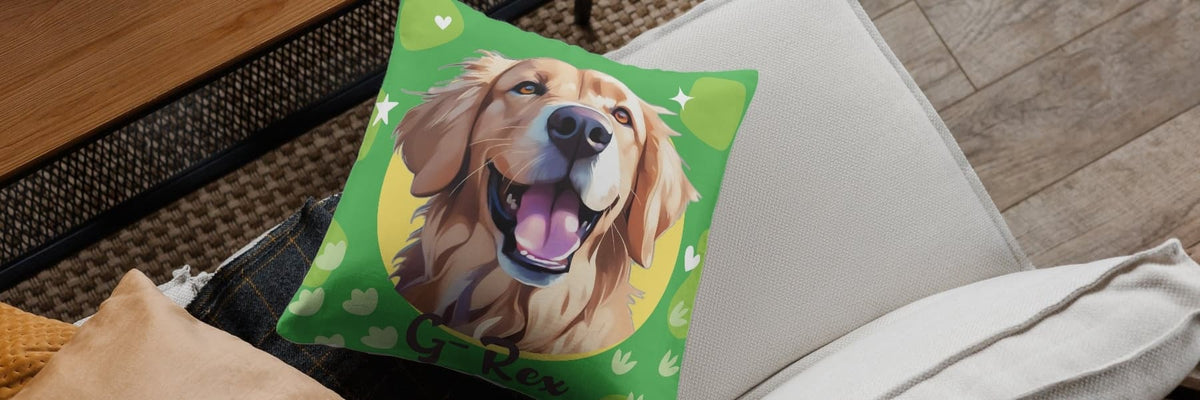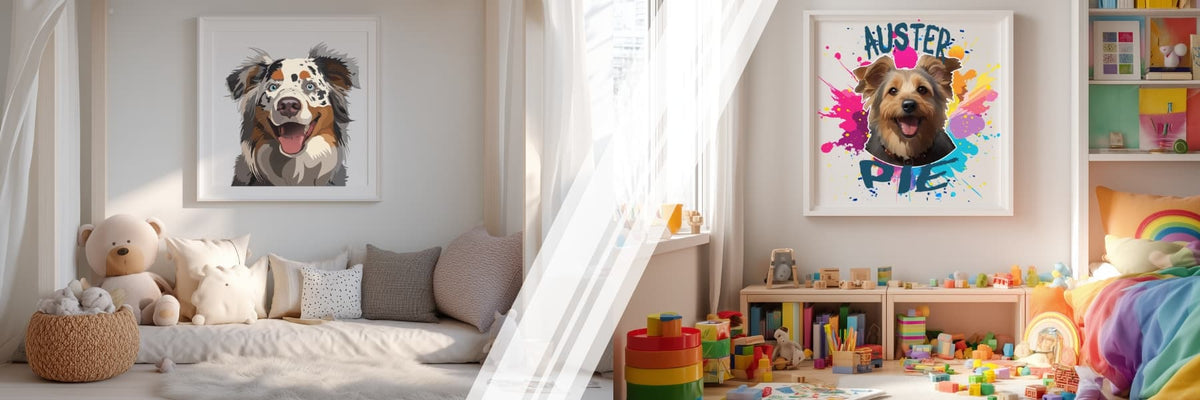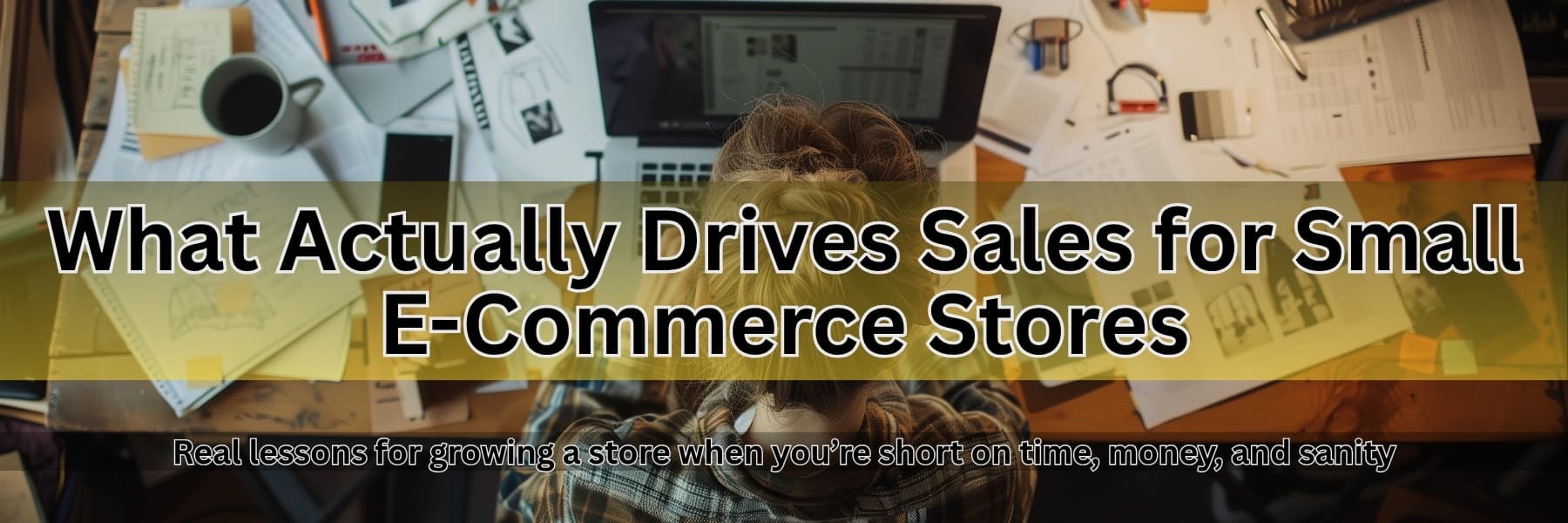Your Photo, Your Design
Get a Custom Artwork Made Just for You!
Turn your favorite photo into a personalized artwork. Whether it's a special memory, a loved one, or a pet, we'll create a unique piece just for you — perfect for gifts or keepsakes.

What Actually Drives Sales for POD Sellers
Or: How to Grow an Online Store with Limited Time, Budget, and Energy.
Let’s be honest: running a small e-commerce business is overwhelming.
Everyone says “you need to do this,” “you should focus on that,” and every strategy sounds important — SEO, ads, social media, email flows, product development, partnerships, listings, video content, on-page optimization, loyalty programs, Pinterest, AI SEO, community outreach… the list never ends.
But for many of us, especially solopreneurs or small teams, there just aren’t enough hours in the day. You're wearing every hat: designer, marketer, writer, analyst, customer support, and creative director — all while still trying to, you know, eat and sleep.
So we asked the question in several e‑commerce communities and forums:
❝ What actually moved the needle for your small store? What turned into real traction — and what was just a time sink? ❞
This article is built entirely on the real, unfiltered experiences of people like you. Some sell custom clothing, others run print-on-demand shops, and a few are bootstrapping niche brands with no big team or VC funding.

🐾 The Work That Pays Off First. Forget the Noise — Focus Here.
If you run a POD store, the overwhelm hits even harder.
You’re not just selling a product — you’re designing it, mocking it up, writing SEO-friendly listings, creating pins, posting reels, adjusting colors, uploading to four platforms, answering DMs, testing bundles, tweaking thumbnails, researching hashtags, managing Etsy / Shopify / Redbubble / Printify / Teespring — all while trying to be creative enough to stand out from every other shop selling similar mugs and shirts.
It’s not that the advice out there is wrong. It’s that most of it assumes you have time, budget, or a team.
“Everyone tells you to make more listings, post more often, try TikTok, start email flows, add bundles, blog, build a Pinterest strategy, and optimize for ChatGPT search... Meanwhile, it’s 11PM and you’re still clipping the background out of a mockup.”
One POD seller described it like this:
“I used to add 10 new listings a week. Then I realized none of them were selling. I didn’t have time to promote anything. I was stuck in this loop — making stuff no one ever saw.”
That’s why this article focuses not on trends or tips, but on prioritization. Because when your energy is limited, the worst thing you can do is try to execute everything badly.
We’ve talked to solopreneurs, POD creators, and small e-commerce founders. Here's what they've shared about what actually drives revenue — especially when your time and capacity are maxed out.
-
🖼️ Your Product Page Is Either Selling — or Pushing People Away
This is the part that makes or breaks everything else.
Whether someone finds you through an Instagram Reel, a Pinterest pin, a Facebook ad, or a Google search, they all land in the same place: your product page. And that page has one job — to convince a stranger to buy from you.
This is where most early sellers struggle, even if they don’t realize it. You can spend hours crafting posts, running ads, or chasing SEO rankings — but if the page people land on is confusing, weak, or dull, you’re burning time and money.
One seller said it bluntly:
“I was trying to grow traffic to a page that didn’t deserve traffic.”
And that’s the trap. We focus on getting more eyeballs before making sure the page is worth seeing.
The moment they stepped back and asked themselves: Would I buy this if I were landing here for the first time? — things began to shift. They cleaned up their mockups. They rewrote the descriptions to sound more like a conversation than a keyword list. They made sure the images matched the tone of the brand — and the product benefits were unmistakably clear.
No tricks. No apps. Just clarity, intent, and better communication.
The change? More people stayed. More people clicked “add to cart.” Abandonments dropped. Sales picked up — without any increase in traffic. Because sometimes, it’s not about getting more people in the room… it’s about finally saying the right thing once they’re there.
-
📬 Email Isn't Dead — It's Where Your Profits Live
If you’ve put off email marketing because it sounds corporate or complicated, you’re not alone. One seller admitted they didn’t even bother with it at first — it felt “like something for brands with marketing teams.”
Then they set up one simple flow: a cart abandonment reminder. And sales started coming in… while they slept.
That’s the thing with email: you don’t need to be great at it. You just need it running. Flows like welcome emails, post-purchase 'thank-you's, and personalized reminders based on browsing behavior can do a ton of revenue lifting — without requiring your daily attention.
What surprised many was how effective emails were after the first purchase. People were more likely to open, more likely to buy again, and more likely to leave reviews if the brand simply stayed in touch.
So no — email isn’t dead. It just needs to be real, helpful, and consistent. And for time-starved solo founders, it’s one of the few marketing tasks you can truly automate and forget (at least for a while).
-
💰 Ads Work — But Only If You’ve Done the Homework
It’s tempting to run ads the moment your store is live. But if your product page isn’t ready, that’s like pouring water into a cracked bucket.
That said, when sellers had a strong listing, even small ad budgets worked. One described running $5/day Facebook campaigns that outperformed their entire social content calendar.
The key wasn’t flashy creative or expensive video — it was knowing what already resonated, and boosting it with a little reach. Another seller ran ads simply to gain page followers, not direct conversions — and found that trust snowballed as their social presence grew.
It’s also worth noting that no one advocated for “scaling hard” or burning through budget blindly. The best results came from controlled, test-driven spending paired with already-performing products.
-
⭐ Trust Is Built — and Reviews Build It Faster
When you're small, new, and unknown, trust is everything.
Some sellers said reviews were the only reason people bought. Others got creative — adding screenshots of customer messages or DMs directly to their product pages. A few used photo reviews and before/after comparisons to show what buyers actually received.
One Shopify seller shared how their Google Business reviews drove more local traffic than any SEO work. Another said they got repeat orders simply because they replied to every review personally and kindly — not with generic “Thanks!” but with warmth, humor, and voice.
Social proof doesn’t require a plugin or widget. It just needs a little intention — and some follow-up.
-
🔁 Repeat Buyers Are Easier to Sell To — So Make It Easy
Finally, sellers who had success consistently mentioned one underappreciated truth: repeat customers are far easier to convert.
So why are most POD shops focused only on first-time sales?
Whether through upsells, cross-sells, bundles, loyalty perks, or post-purchase thank-you offers, sellers who built even the simplest retention system saw big results over time.
A few didn’t use apps at all. They just sent personalized follow-up messages. Or included a coupon in the order email. Or offered a freebie on the second order. The tools didn’t matter. The intentionality did.
One seller put it best:
“My shop’s small. I can’t outspend anyone. But I can make people feel like they’re buying from a real person. That’s my retention strategy.”
Bottom line? If you’re short on time, these are the places to focus. Not because gurus say so. But because people in the trenches — solopreneurs like you — consistently said these are the only things that made money early.
It’s not fast. But it works.
-
📌 Pinterest & Quora: The Quiet Engines of Long-Term Visibility
These two platforms don’t get as much hype as TikTok or Instagram, but for many small e‑commerce sellers — especially in print-on-demand — they quietly outperform almost everything else over time.
They’re not about viral moments. They’re about long shelf life.
Sellers described Pinterest as more of a search engine than a social feed. A well-optimized pin can appear in Google Images, Pinterest search, and even show up in tools like Google Lens or SGE — months after it was posted.
Quora works the same way. It's not about posting daily or chasing likes. It's about writing one well-placed, useful answer to a customer question, and letting it drive traffic week after week, often showing up in AI-powered answers or search snippets.
Neither platform is magic. But when your listings are already solid, your email flows are working, and you’ve got a product worth discovering — this kind of search-driven exposure keeps paying off long after the post is published.

🧰 Good Add-Ons — But Only If the Core Is Working
If the previous section is about setting up the engine of your store, this one is about pressing the gas once you know it runs.
A lot of sellers rush into this tier too early — usually because these are the loudest tactics online. This is the stuff you see everyone shouting about on YouTube, Reddit, or Shopify groups.
But what many fail to mention is that most of these strategies don’t work unless your product pages already convert and your retention systems are already capturing repeat buyers.
So — once you’ve got the basics covered, here’s where these actions can start making sense.
-
🧵 Product Development: Only After You Know What Sells
It’s tempting to keep making new designs — especially in POD where creativity flows easily and uploading new products feels productive. But many sellers realized that churning out more listings was only giving them… more listings.
More to manage. More to market. More to optimize. But not necessarily more sales.
“Once I identified my best-selling item, I stopped uploading random stuff and started building around that.”
That shift — from creating new to doubling down on what already works — is where product development starts paying off. Bundling your winning product with a matching file. Offering it in a different art style. Turning it into a sticker pack or a printable version. That’s when development becomes strategic, not just busywork.
-
📱 Organic Social Media: Worth Doing If You’re Good at It — or Enjoy It
Some people are natural creators. They love making Reels, TikToks, behind-the-scenes content. And for them, organic social works.
But several honest sellers admitted the opposite: they hated social, or didn’t see real results. Posting daily felt exhausting. Growth was slow. Engagement was low. And conversions? Often disappointing.
“I’m not a content creator. I’d rather spend that time improving my store.”
Still, even for non-creators, it’s worth claiming your space:
- Create a branded Instagram and Facebook page early (just to look legit)
- Post a few polished pieces to show your aesthetic and product range
- Use social proof from happy buyers to fill out your grid
From there, grow if it makes sense. But don’t treat social as mandatory hustle if you’re already short on time and it’s not driving traffic yet.
-
🎥 Video Content & Influencer Marketing: High Effort, Mixed Results
This one came with caveats across the board.
Some sellers had luck with micro-influencers or user-generated content (UGC), especially when working on commission or barter. Others said they paid for shootouts and got nothing.
Many agreed: video content is powerful — but time-consuming and unpredictable.
“I tried video ads and influencer posts. No spike in sales. Maybe my product wasn’t visual enough. Or maybe I didn’t know how to frame it.”
A recurring theme here: if you're going to test video or influencer marketing, keep your investment small and expectations realistic. And always track results before doubling down.
In the long run, having even a handful of UGC-style product clips can help — especially for paid retargeting ads. But it’s not the first place to spend your time if you’re already struggling to keep up.
-
💬 Sales, Discounts, and Giveaways: Flashy, but Often Shallow
For most small shops — especially in POD — sales and discounts are tempting because they feel actionable. You can launch a weekend promo, post it everywhere, and watch for results. But the truth many sellers discovered is this:
Discounts don’t create demand — they only accelerate it.
If people already want what you're selling, a discount can give them the final push. But if your product isn’t converting at full price, dropping it by 20% or 30% rarely changes that.
One seller shared how they tested a 15% off sitewide sale and got a small bump in orders — but mostly from people who had already been thinking about buying. It didn’t attract new traffic. It just nudged warmer leads over the line.
Others reported running sales that got little to no response — and left them feeling like they’d just undercut themselves for nothing.
That said, targeted promos can work well:
- Offering a discount after first purchase (to encourage repeat buyers)
- Giving returning customers a “thank-you code” in post-purchase emails
- Using limited-time bundles during seasonal periods like Christmas or Valentine’s Day
- Running free shipping thresholds to increase AOV (average order value)What didn’t work? Constant markdowns. Blanket discounts without context. Promos that felt like desperation instead of strategy.
Ultimately, if you're going to run a sale — make it intentional, rare, and clearly framed. Not “because you haven’t had sales lately,” but because the moment is right and your product is worth buying at either price.
-
🤝 Affiliate Marketing & Partnerships: Low-Risk, Long-Term
The idea of letting others do the selling came up more than once — and for good reason. If you find the right people to promote your products, it’s a win-win.
But most agreed that finding those people — and building the right system — takes time. It’s not a quick-growth tactic. It’s an ecosystem move.
“I let a few people from my university promote my designs. They got a cut. I got traffic and sales. It worked — but only because they were motivated.”
If you’re in a niche with community creators, micro-influencers, or Facebook group leaders, partnerships can pay off over time. But don’t expect to launch an affiliate program and watch sales roll in. Like most Tier 2 tactics, it only works when you already have something that converts.
🐢 Long Game Strategies (Useful, But Slow to Pay Off)
There’s nothing wrong with long-term thinking. In fact, it’s essential for sustainable growth. But when you're running a small POD or e-commerce store alone — limited on time, budget, or emotional bandwidth — not every “smart idea” is smart right now.
The strategies below aren’t fake. They’re not hype. But they take time. And for most solo store owners we heard from, they only became worth investing in after the basics were already profitable.
So if you’re not doing these yet? That’s fine. You’re not behind. You’re focused.
-
📝 Blogging, SEO, and Backlinks: Real Authority — Just Not Right Away
There’s a lot of advice out there saying every store needs a blog. And in theory, it makes sense: blogs can build topical authority, help you rank in Google, and educate buyers.
But the real talk from sellers?
“It’s a good idea. But when I was barely keeping up with orders and mockups, blogging was never the priority.”
A few who did blog regularly saw results — especially for evergreen posts like:
- “Best Gifts for Dog Lovers Under $30”
- “How to Use Custom Portrait Stickers in Your Scrapbook”
- “Why Personalized Mugs Are Still the Perfect Birthday Gift”Those kinds of articles can rank in search, earn backlinks, and even get pulled into AI-generated summaries (SGE, ChatGPT, Bing).
But it’s a commitment. And unless you love writing or have someone doing it for you, it’s okay to let this wait until your product listings, email flows, and ads are already bringing in revenue.
The same goes for backlink outreach. It works — eventually. But it's not where small, time-strapped sellers should focus first.
-
🧑🤝🧑 Community Engagement: Slow, Human Growth
Forums, Facebook groups, Discords — these can build deep relationships, but not fast sales.
People buy from those they trust, and trust takes time to earn. Sellers who did this well didn’t drop links; they showed up, answered questions, offered advice, and only mentioned their products when it felt natural.If you’re the kind of person who enjoys interaction, it’s a good long‑term move. If you’re drained by constant conversation, focus elsewhere until you can delegate it.
-
🤖 AI‑Driven Visibility (SGE, ChatGPT, Bing Copilot)
A few sellers mentioned something curious: their Quora answers or blog posts had started showing up in AI-generated results — not because they chased it, but because the content was structured, helpful, and branded clearly.
This isn’t something you can force. You won’t see overnight wins by “optimizing for ChatGPT” — at least not yet. But the game is shifting.
As tools like Google’s SGE, Bing Copilot, and ChatGPT’s Browse mode evolve, they’re starting to recommend not just keywords — but actual brands and creators. And when that moment hits, your content has to be readable, findable, and structured in a way AI can understand.
That means writing like a human, yes — but also making sure your brand name shows up naturally in your descriptions, that your blog content answers questions people are actually asking, and that your website isn’t a maze of vague titles and missing metadata.
It’s not about gaming the system. It’s about getting your content ready for the shift that’s already happening. Quiet prep, with long-term benefits.
-
🏞️ Offline Marketing: Surprisingly Effective (When You Have the Energy)
Most online sellers underestimate how much the physical world still influences digital sales. But several POD founders who joined the conversation said that some of their best traction came not from another social post, but from simply showing up — literally.
One small apparel seller told us they started printing a few T‑shirts from their own designs and wore them everywhere: coffee shops, local fairs, even the gym. People asked where they got them, and that turned into conversations, then QR‑code scans, then sales. Another described setting up a tiny booth at a weekend market with nothing more than a tablet showing mock‑ups and a stack of business cards. It didn’t make them rich, but it gave them something rare online — trust.
Others found that mailing simple postcards to local businesses or leaving a few samples in nearby cafés was enough to drive curious traffic back to their store. It’s slower than ads, sure, but it builds familiarity. And familiarity sells.
The point isn’t to replace digital marketing. It’s to remember that people still respond to human interaction and tangible proof. When you’re burned out from algorithms and platforms that change weekly, walking outside with your own product in hand can sometimes do more than another round of A/B testing.
For many POD sellers, the internet is crowded, but your local world probably isn’t. Showing up there might just be the quietest — and smartest — way to get noticed.
🧵 Final Thoughts
If there's one thing that came through clearly in all the feedback, it's this: you can’t do everything — and you don’t need to.
Every small shop owner we spoke to had a moment where they were juggling too much. Some were pouring time into content that never got seen. Others were stuck chasing traffic while their product pages didn’t convert. A few were trying to build loyalty programs before even getting their first repeat buyer.
But the ones who started to see real traction? They focused.
They doubled down on what actually brought results — improving one listing that already sold, setting up a simple email flow, following up with past customers, fixing the page that people were already landing on. Nothing fancy. Nothing that requires a team. Just small decisions that gave them space to keep going.
Not everything on your list matters equally. Some things help right now. Others can wait. A few might never be worth your time at all. And that’s okay.
So if you’ve been staring at a giant to-do list, feeling like you’re constantly behind — maybe you’re not behind at all. Maybe you’re just one decision away from giving yourself permission to do less, but do it better.
That’s where real growth comes from.
- Choosing a selection results in a full page refresh.






